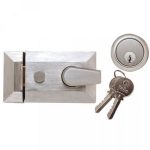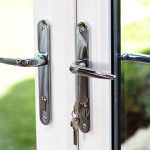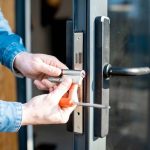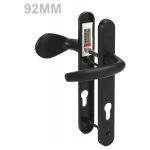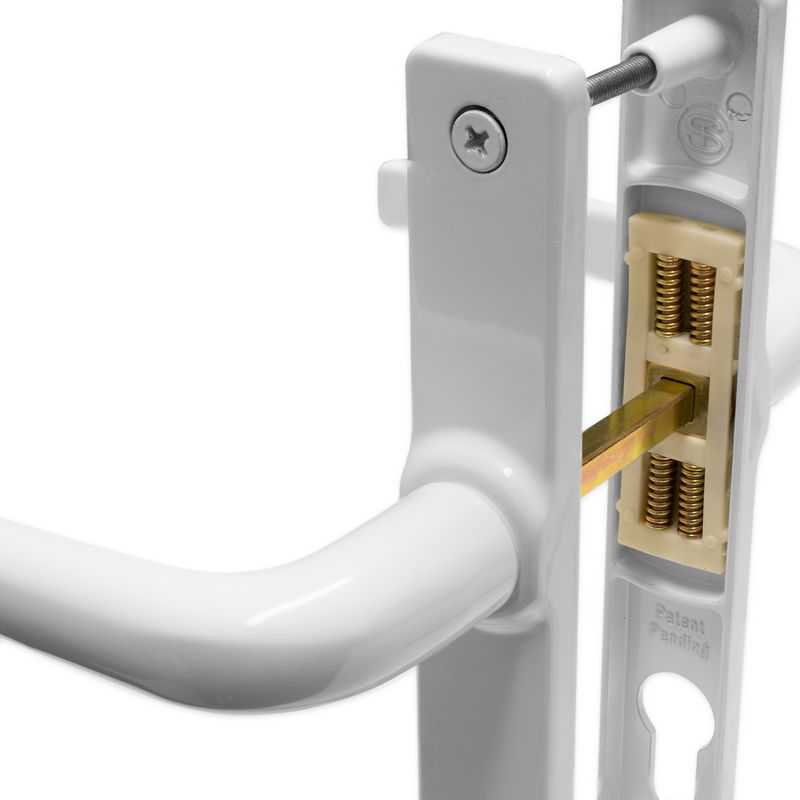
My uPVC Door Handle is Floppy or Loose – Price To Repair + Is a New Handle is Required?
Is your uPVC door handle starting to feel loose and floppy? If so, it may be time to consider a repair or invest in a new handle. A loose or floppy handle not only affects the security and functionality of your door but also detracts from its overall appearance.
Repairing a loose uPVC door handle can save you money compared to buying a new one. Often, the issue can be resolved by tightening a few screws or adjusting the latch mechanism. However, if the handle is damaged or worn out, it may not be possible to fix it.
If you find that your uPVC door handle is beyond repair, investing in a new one is a wise choice. A high-quality handle will not only enhance the security of your door but also add a touch of style to your home exterior. It’s important to consider the price, durability, and design when choosing a new handle.
Don’t overlook the importance of a sturdy and reliable uPVC door handle. Whether you need a repair or a new handle, finding the right solution is crucial to ensure the safety and functionality of your door.
Is Your uPVC Door Handle Floppy or Loose?
If your uPVC door handle is floppy or loose, it can be frustrating and potentially a security risk. Luckily, there are steps you can take to repair it and determine if a new handle is required.
First, try tightening the screws on the handle using a screwdriver. In many cases, a loose handle is simply due to loose screws. If this doesn’t solve the problem, you may need to replace the screws with longer ones or use a thread-locking adhesive to secure them in place.
If the handle is still floppy after tightening the screws, you may need to replace the handle itself. uPVC door handles come in a variety of styles and prices, so you can choose one that matches your aesthetic preferences and budget.
When selecting a new handle, consider the quality and durability of the material. Look for handles made from durable materials like stainless steel or brass, as these will be less likely to become loose over time. You should also check if the handle is compatible with your door, as some handles are specifically designed for certain types of uPVC doors.
Before purchasing a new handle, it’s a good idea to check if it can be repaired. Some handles may have parts that can be fixed or replaced, saving you money in the long run. You can consult a professional to determine if repair is possible or if a replacement is necessary.
Remember, a floppy or loose uPVC door handle not only affects the functionality and security of your door but also the overall aesthetic of your home. Take the necessary steps to repair or replace your handle to ensure your uPVC door is in top shape.
Learn How to Repair It
If your uPVC door handle is floppy or loose, it may need some repair work. Fortunately, fixing a floppy handle is a relatively simple task that you can do yourself. Follow these steps to repair your handle:
- Step 1: Inspect the handle. Check for any visible signs of damage or wear.
- Step 2: Tighten the handle screws. Use a screwdriver to tighten the screws that hold the handle in place. This can often solve the problem of a loose handle.
- Step 3: Lubricate the handle mechanism. Apply a few drops of lubricating oil to the moving parts of the handle to help reduce friction and improve its functionality.
- Step 4: Check the spindle length. In some cases, a floppy handle may be the result of a spindle that is too short. If this is the case, you may need to replace the spindle with a longer one.
- Step 5: Test the handle. Check if the handle is now secure and functions properly. If it is still floppy or loose, you may need to invest in a new handle.
While repairing a floppy handle can often solve the problem, in some cases, a replacement handle may be required. The price of a new handle will depend on the style and quality you choose. It is recommended to consult with a professional or visit a hardware store to get advice on the best handle for your needs and budget.
Remember, having a sturdy and secure door handle is important for the safety and security of your home. Don’t ignore a floppy or loose handle, as it can be an entry point for potential intruders. Take the necessary steps to repair or replace your handle to ensure the continued functionality and security of your uPVC door.
Step 1: Identify the Problem
If your uPVC door handle is feeling floppy or loose, it is important to inspect it to determine the cause of the issue. By identifying the problem, you can determine whether a repair is possible or if a new handle is required.
Here are some common issues to look out for:
| The handle is loose and wobbles when touched |
| The handle does not fully engage with the door mechanism |
| There are visible signs of wear and tear on the handle |
To begin the identification process, gently grip the handle and try to wiggle it. If it moves easily or feels unstable, you may have a loose handle. If the handle does not properly connect with the door mechanism, it may be misaligned or worn down.
Inspect the handle for signs of wear and tear, such as scratches, cracks, or discoloration. These can indicate that the handle has reached the end of its lifespan and requires replacement.
By identifying the specific problem with your uPVC door handle, you can determine the appropriate course of action. In some cases, a repair may be possible by tightening screws or adjusting alignment. However, if the handle is significantly damaged or worn, investing in a new handle may be the best solution.
Step 2: Tighten the Screws
If your uPVC door handle feels floppy or loose, it may be due to loose screws. In this step, we’ll show you how to tighten the screws to restore the stability of your handle.
To begin, you’ll need a screwdriver that matches the size of the screws on your handle. If you don’t have one, they can be easily purchased at a reasonable price from your local hardware store.
First, locate the screws on your handle. They are usually found on the inside panel of the door, near the base of the handle. Use your screwdriver to tighten each screw by turning it clockwise. Be careful not to overtighten, as this can strip the screw or damage the handle.
Once you have tightened all of the screws, test the handle to see if it feels more secure. If it is still loose or floppy, you may need to invest in a new handle.
Repairing a loose uPVC door handle is a simple and cost-effective solution to improve the functionality and security of your door. By following these steps, you can ensure that your handle is secure and reliable for everyday use.
Step 3: Lubricate the Mechanism
If your uPVC door handle is floppy or loose, it may simply require some lubrication to fix the issue. This step can often solve the problem without the need for a costly repair or investment in a new handle.
Start by purchasing a suitable lubricant specifically designed for uPVC door handles. These can usually be found at your local hardware store or online. It is important to choose a lubricant that is safe for use on uPVC to avoid causing any damage to the handle or mechanism.
Once you have the required lubricant, follow these steps to properly lubricate the mechanism:
- Step 1: Ensure the door is closed and locked for safety.
- Step 2: Locate the small hole or slot on the handle where the spindle enters the mechanism. This is usually found near the base of the handle.
- Step 3: Apply a small amount of lubricant to a cloth or paper towel.
- Step 4: Insert the cloth or paper towel into the hole or slot and gently wipe the lubricant onto the spindle and other moving parts of the mechanism.
- Step 5: Work the handle back and forth several times to distribute the lubricant evenly.
- Step 6: If necessary, apply a second round of lubricant for additional protection and smooth movement.
After completing these steps, your uPVC door handle should no longer be floppy or loose. If the issue persists, it may indicate a more serious problem and you may need to consider investing in a new handle. However, lubrication is often a simple and affordable way to restore functionality to your handle.
Step 4: Replace Worn-out Parts
If your uPVC door handle is still loose or floppy even after attempting to repair it, then it may be time to consider replacing worn-out parts. This step may be required if the handle is beyond repair or if the cost of repair is no longer viable.

Before purchasing a new handle, it is important to identify the specific parts that need replacing. Typically, these include:
- The handle itself, which may have worn grooves or become loose
- The spindle, which connects the handle to the locking mechanism and may have bent or corroded
- The fixing screws, which may be worn or damaged
Once you have identified the parts that need replacing, research the available options and compare prices. It’s important to choose high-quality replacement parts to ensure durability and proper functionality.
The price of a new handle can vary depending on the brand, material, and design. Consider your budget and the specific requirements of your door before making a purchase.
When replacing the worn-out parts, refer to the manufacturer’s instructions or seek professional assistance if needed. Follow the proper guidelines to ensure a successful replacement and to avoid any potential damage to your door. Remember to always use the proper tools and take necessary safety precautions.
By replacing the worn-out parts, you can restore the functionality and appearance of your uPVC door handle, providing a secure and reliable solution for your home or property.
Step 5: Test and Adjust the Handle
Once you have completed the repair process for your loose or floppy uPVC door handle, it is essential to test it to ensure it is securely in place and functions properly. Testing the handle is an important step to avoid any unexpected issues in the future, as a loose handle can compromise the security and functionality of your door.
To test the handle, simply open and close the door multiple times while paying attention to how the handle responds. Check for any signs of looseness, wobbling, or difficulty in operation. If you notice any of these issues, it may indicate that further adjustments are needed.
Adjusting the handle can be a simple process that requires tightening or realigning certain parts. Start by examining the handle and identifying any visible screws or bolts that connect the handle to the door. Use a screwdriver or the appropriate tool to tighten these screws or bolts, ensuring they are securely fastened.
If tightening the screws or bolts does not resolve the issue, further adjustments may be necessary. Check for any other adjustable components, such as a set screw or an adjustable spindle. These mechanisms can be turned or adjusted to correct the handle’s position or tightness.
Make small adjustments at a time, testing the handle after each adjustment to determine whether the issue has been resolved. Avoid over-tightening or forcing any parts, as this can lead to damage or breakage.
If you find that even after testing and adjusting the handle, it still remains loose or floppy, it may be time to invest in a new handle. While the price of a new handle may initially seem like an expense, it is a worthwhile investment in ensuring the long-term functionality and security of your uPVC door.
By completing the repair process and testing the handle thoroughly, you can determine whether further adjustments or a new handle is necessary. Investing the time and effort now can save you from future issues and provide peace of mind knowing that your uPVC door is secure and functioning optimally.
Find Out If You Need to Invest in a New Handle
If your uPVC door handle is loose or floppy, it can be quite frustrating and affect the security of your door. In some cases, a loose handle can be easily repaired, but in other situations, it may be necessary to invest in a new handle.
Price: One of the factors to consider when determining if you need a new handle is the price of repairing it versus buying a new one. If the repair cost is close to or exceeds the price of a new handle, it may be more cost-effective to simply invest in a new one.
Extent of Damage: Another factor to consider is the extent of the damage to the handle. If the handle is only slightly loose and can be easily tightened, a repair may be sufficient. However, if the handle is severely damaged or worn out, a new handle might be required.
Safety and Security: The safety and security of your door should be a top priority. If a loose or floppy handle compromises the functionality of your door and affects its ability to lock properly, it is essential to invest in a new handle to ensure the safety of your home or business.
Long-Term Solution: Lastly, consider the long-term solution. If your current handle is prone to becoming loose or floppy due to wear and tear, investing in a new handle made of high-quality materials can provide a longer-lasting solution, saving you time and money in the future.
In conclusion, whether to repair or invest in a new handle depends on factors such as price, the extent of the damage, safety and security concerns, and finding a long-term solution. Consulting with a professional can help you determine the best course of action for your uPVC door handle.
Signs of Irreparable Damage
If you have attempted to repair your floppy or loose uPVC door handle and it is still not functioning properly, there may be signs of irreparable damage. It is important to identify these signs to determine if a new handle is required.
1. Persistent Floppiness: If your door handle continues to be loose or floppy despite your repair efforts, this may indicate that the damage is beyond repair. A loose handle can compromise the security of your door, as it may not properly latch or lock.
2. Visible Wear and Tear: Inspect your handle for any visible signs of wear and tear, such as cracks, breakage, or significant damage. If the handle appears to be heavily damaged, it may be necessary to invest in a new handle.
3. Inability to Tighten: If you are unable to tighten the handle using standard repair methods, such as tightening screws or adjusting components, this could indicate that the handle is beyond repair. A loose handle that cannot be tightened may pose a safety risk and should be replaced.
4. Functionality Issues: If your handle is not functioning properly, such as difficulty in turning or sticking, this could be a sign of irreparable damage. An unreliable handle can lead to further damage or wear on other door components, making a new handle necessary.
5. Limited Repair Options: If you have exhausted all possible repair options and the handle still remains loose or floppy, it may be time to consider investing in a new handle. Continuing to use a damaged handle can lead to further complications and potential security risks.
By recognizing these signs of irreparable damage, you can make an informed decision about whether a new handle is required for your uPVC door. Remember, a secure and properly functioning handle is crucial for the safety and security of your home or business premises.
Quality and Durability of Replacement Handles
When your uPVC door handle becomes floppy or loose, it’s important to address the issue promptly to ensure the security of your property. While a repair might temporarily fix the problem, investing in a new handle can provide a more reliable and long-lasting solution.
At [Company Name], we understand the frustration that comes with a faulty handle, which is why we offer a wide range of high-quality replacement handles. Our handles are designed with durability in mind, ensuring they can withstand the daily wear and tear of regular use.
When choosing a new handle for your uPVC door, it’s essential to consider both the quality and the price. Cheaper handles may seem like a cost-effective option in the short term, but they often lack the durability needed to withstand constant use. This can result in frequent repairs or the need for another replacement handle, ultimately costing you more in the long run.
Our replacement handles are specifically crafted to provide exceptional quality and longevity. Made from sturdy materials and constructed with precision, our handles are built to last. Additionally, we offer a range of styles and finishes to suit your aesthetic preferences.
Investing in a new handle from [Company Name] not only ensures the security of your property but also provides peace of mind. With our high-quality handles, you can trust that your uPVC door will remain sturdy and secure for years to come.
Q&A:
My uPVC door handle is loose, what should I do?
If your uPVC door handle is loose, you can try to repair it yourself before deciding if you need to invest in a new handle. There are a few steps you can take to fix a loose handle, such as tightening the screws or adjusting the spindle. If these methods don’t work, it might be time to consider buying a new handle.
What can cause a uPVC door handle to become floppy?
A uPVC door handle can become floppy due to several reasons. One common cause is the wear and tear of the internal components, such as the springs and the spindle. Other factors that can contribute to a floppy handle include loose screws or a misaligned handle. If your handle is floppy, it’s important to identify the cause in order to determine the best course of action.
Can I repair a floppy uPVC door handle myself?
Yes, you can try to repair a floppy uPVC door handle yourself. Start by tightening any loose screws on the handle. If that doesn’t solve the problem, you can try adjusting the spindle or replacing the internal components, such as the springs. However, if the handle continues to be floppy even after attempting these repairs, it might be time to invest in a new handle.
How do I know if I need to invest in a new uPVC door handle?
If you’ve tried to repair your uPVC door handle and it’s still floppy or loose, it might be time to invest in a new handle. Additionally, if the handle is visibly damaged or worn out, it’s a good indication that it needs to be replaced. It’s important to have a sturdy and secure handle for your door, so if you’re unsure about the condition of your current handle, it’s always better to err on the side of caution and get a new one.
What should I look for when buying a new uPVC door handle?
When buying a new uPVC door handle, there are several factors to consider. First, make sure the handle is compatible with your door and its mechanism. Look for handles made from durable materials, such as stainless steel or solid brass, for longevity. Consider the design and style of the handle to ensure it matches your door and personal preferences. Finally, check for any additional features, such as a lock or a key, depending on your security needs.
Why is my uPVC door handle floppy or loose?
Your uPVC door handle may be floppy or loose due to wear and tear over time. The internal springs and mechanisms can become worn, causing the handle to become loose.
